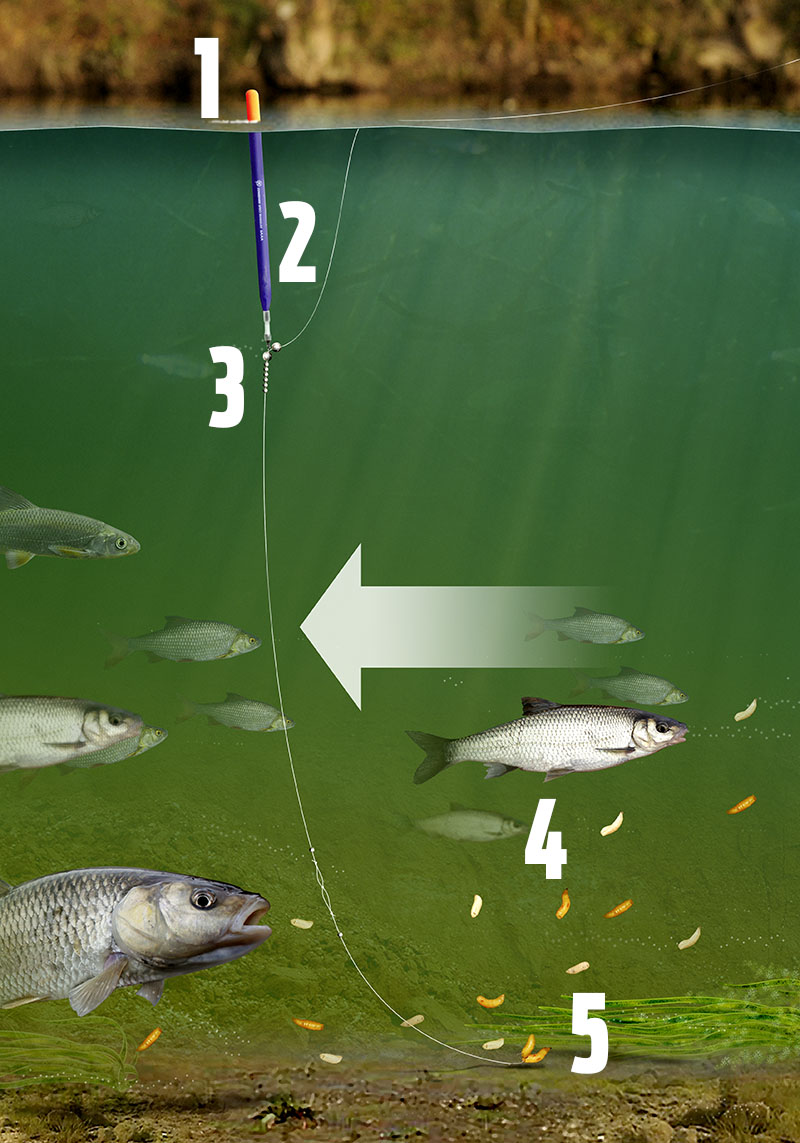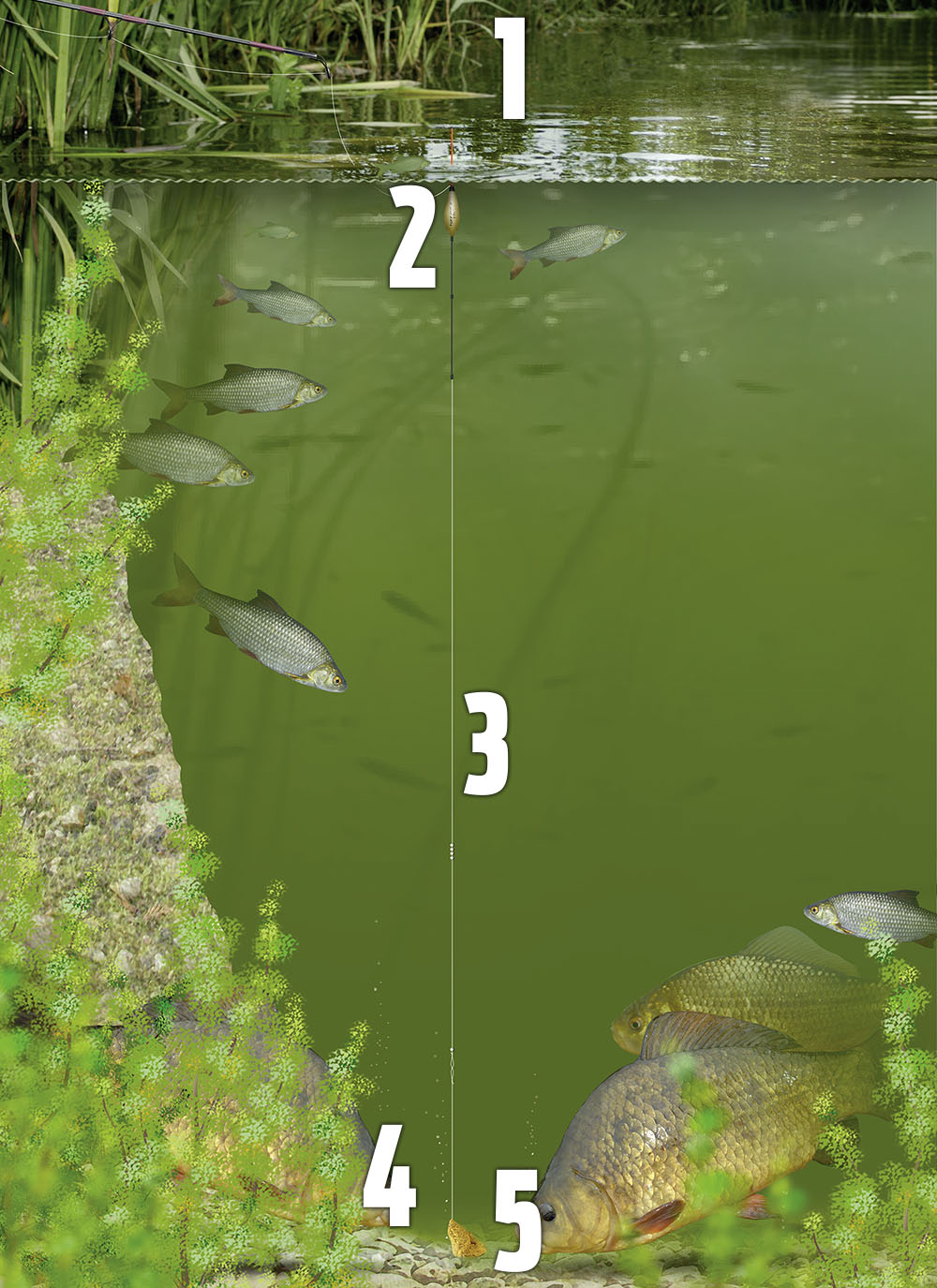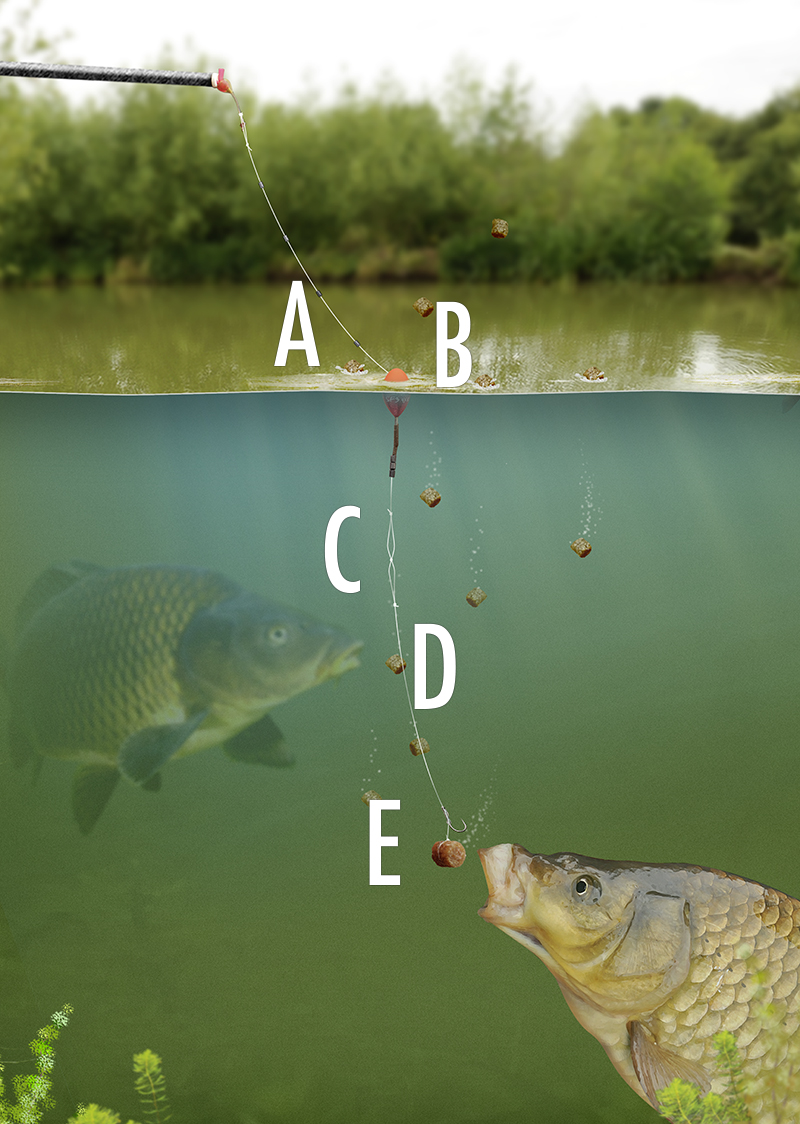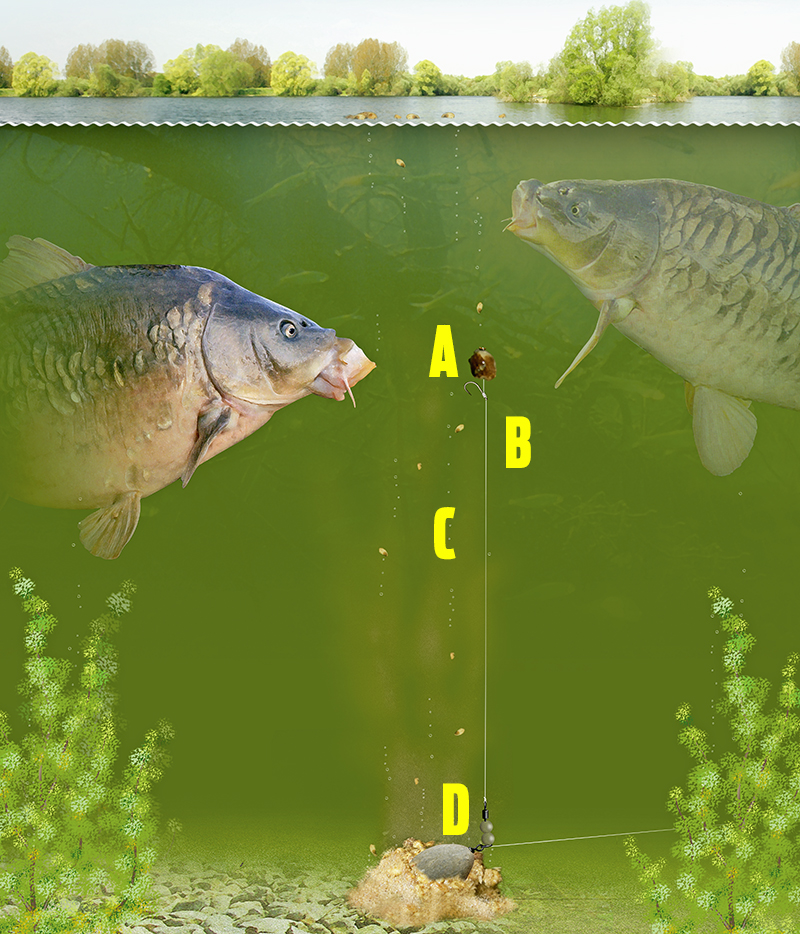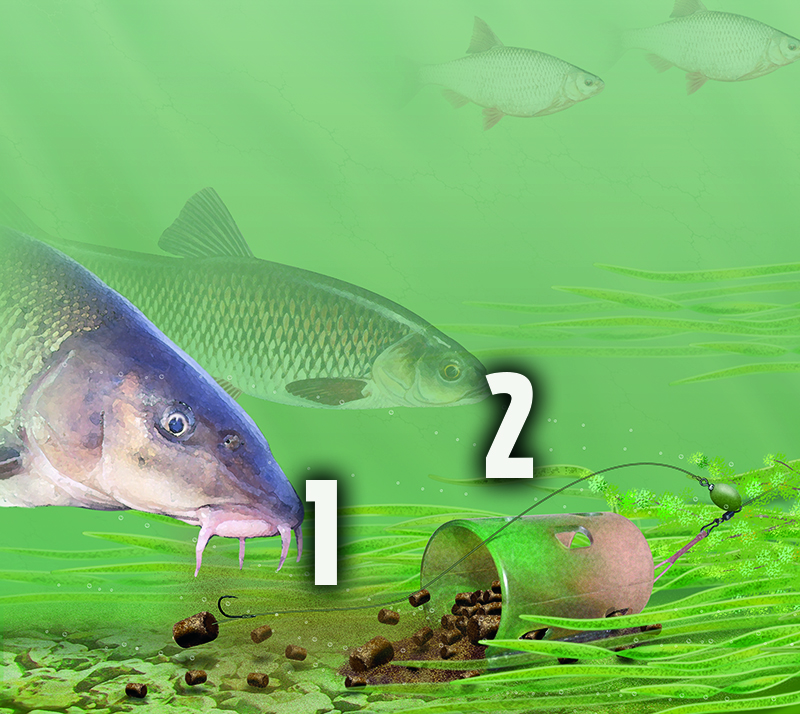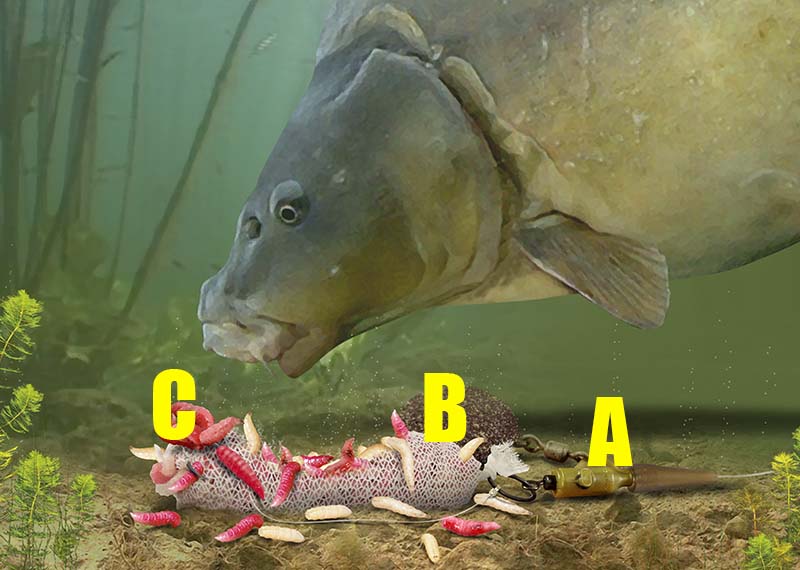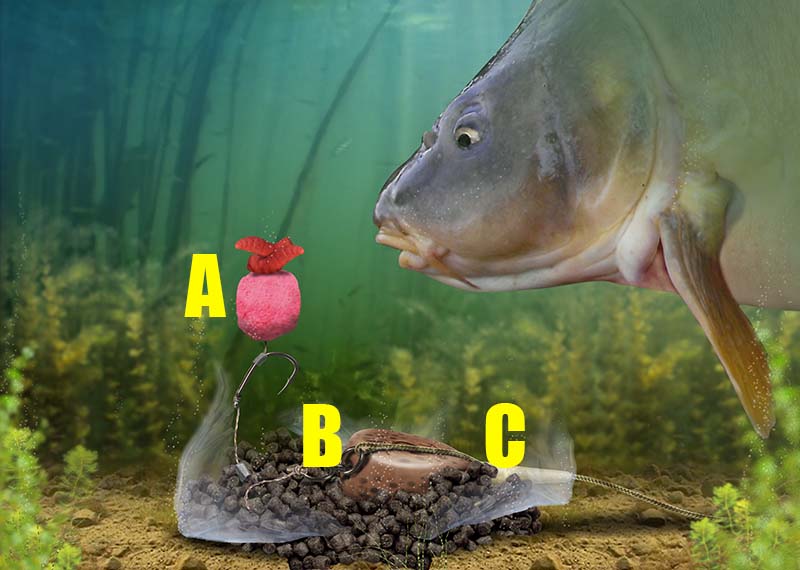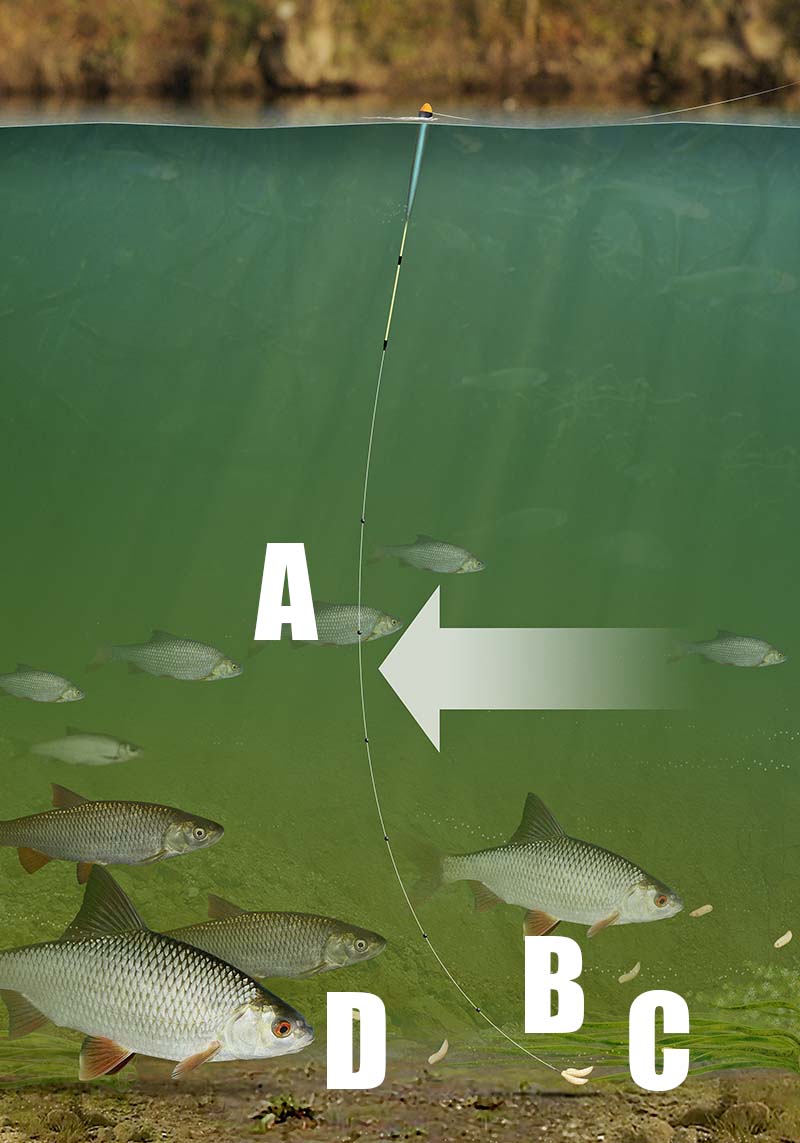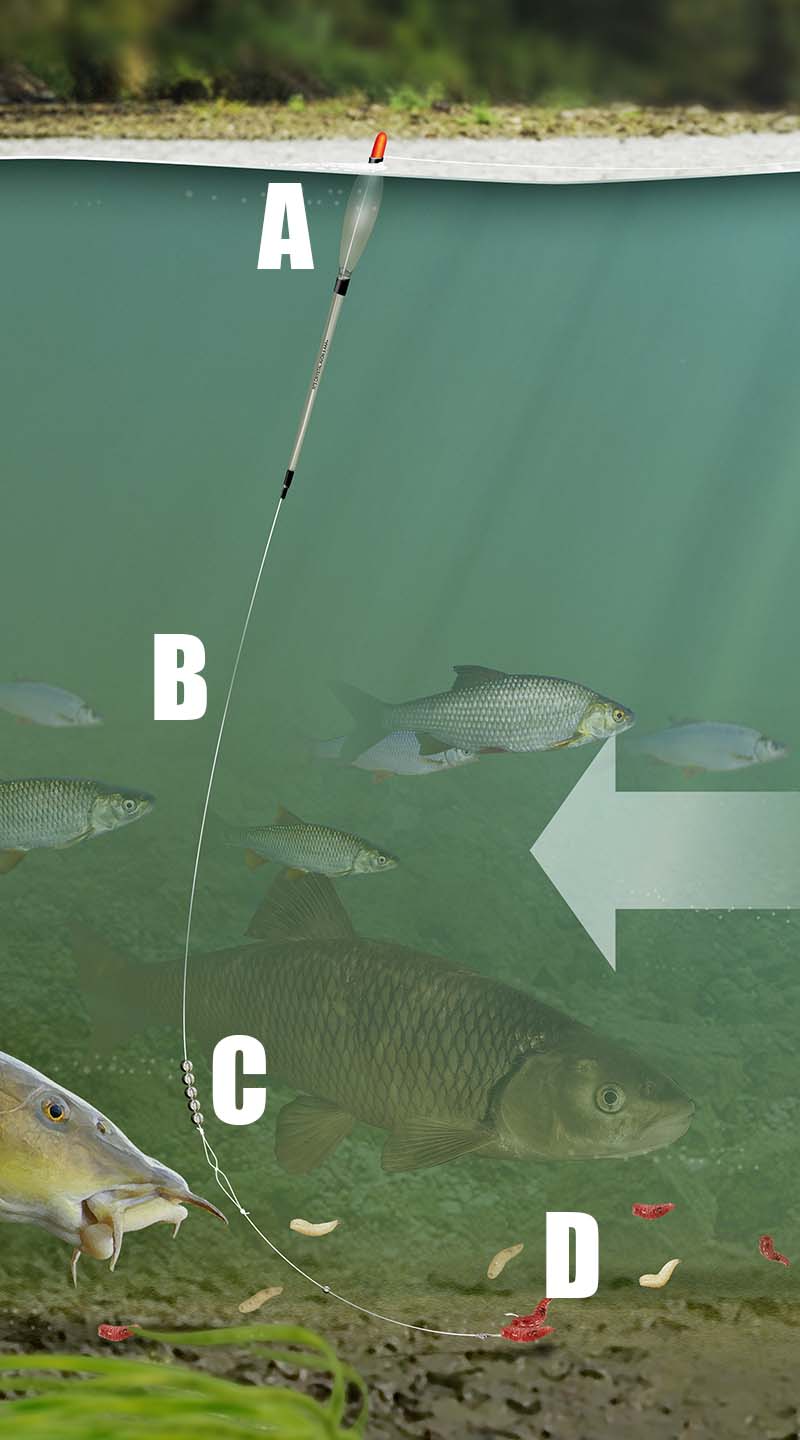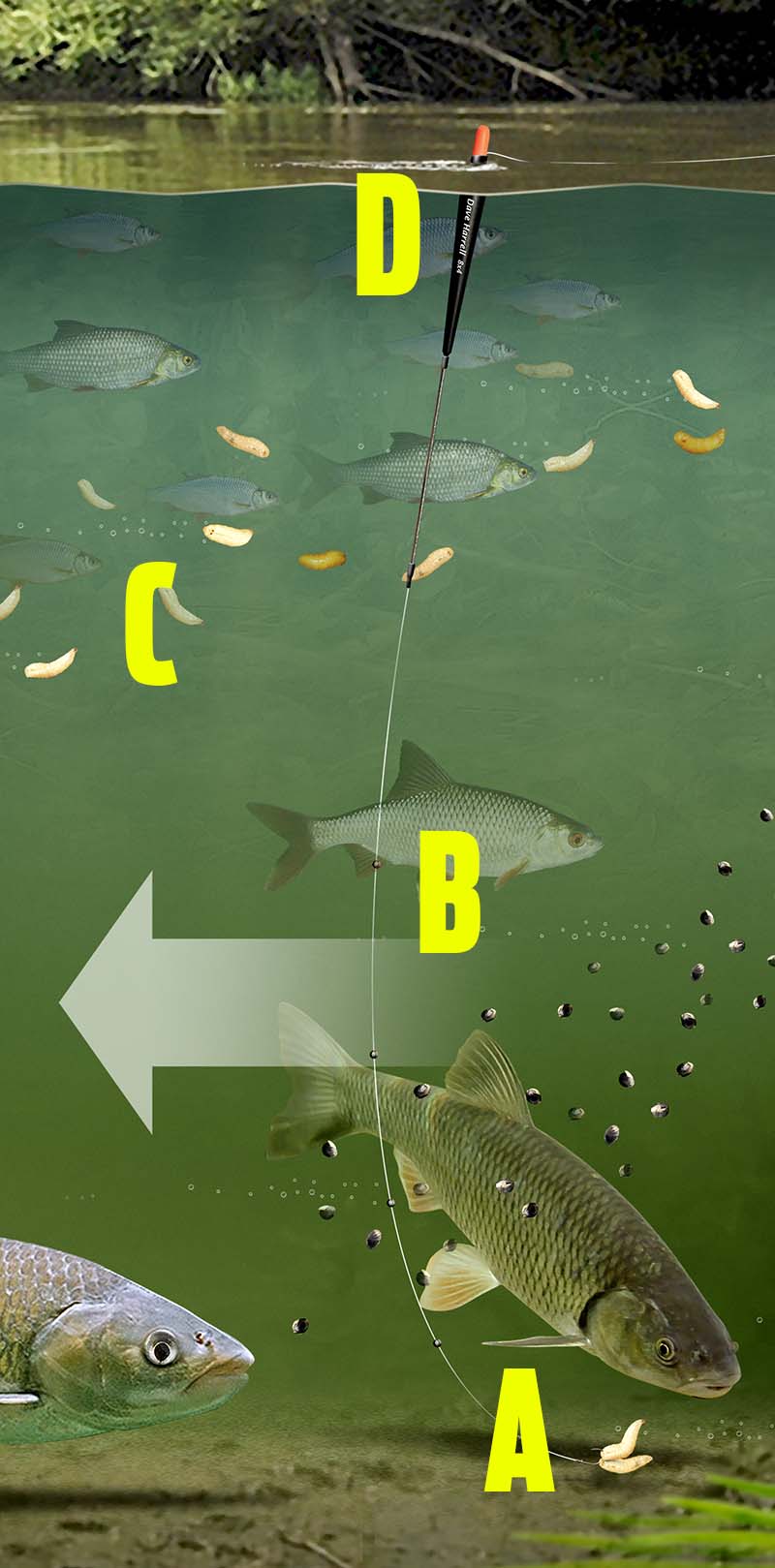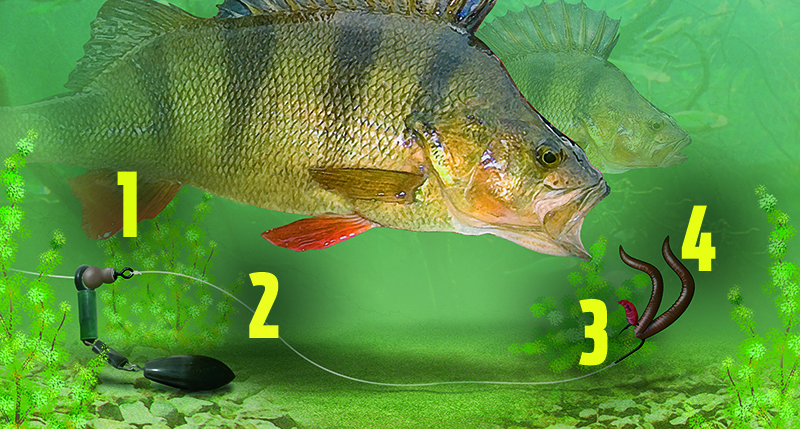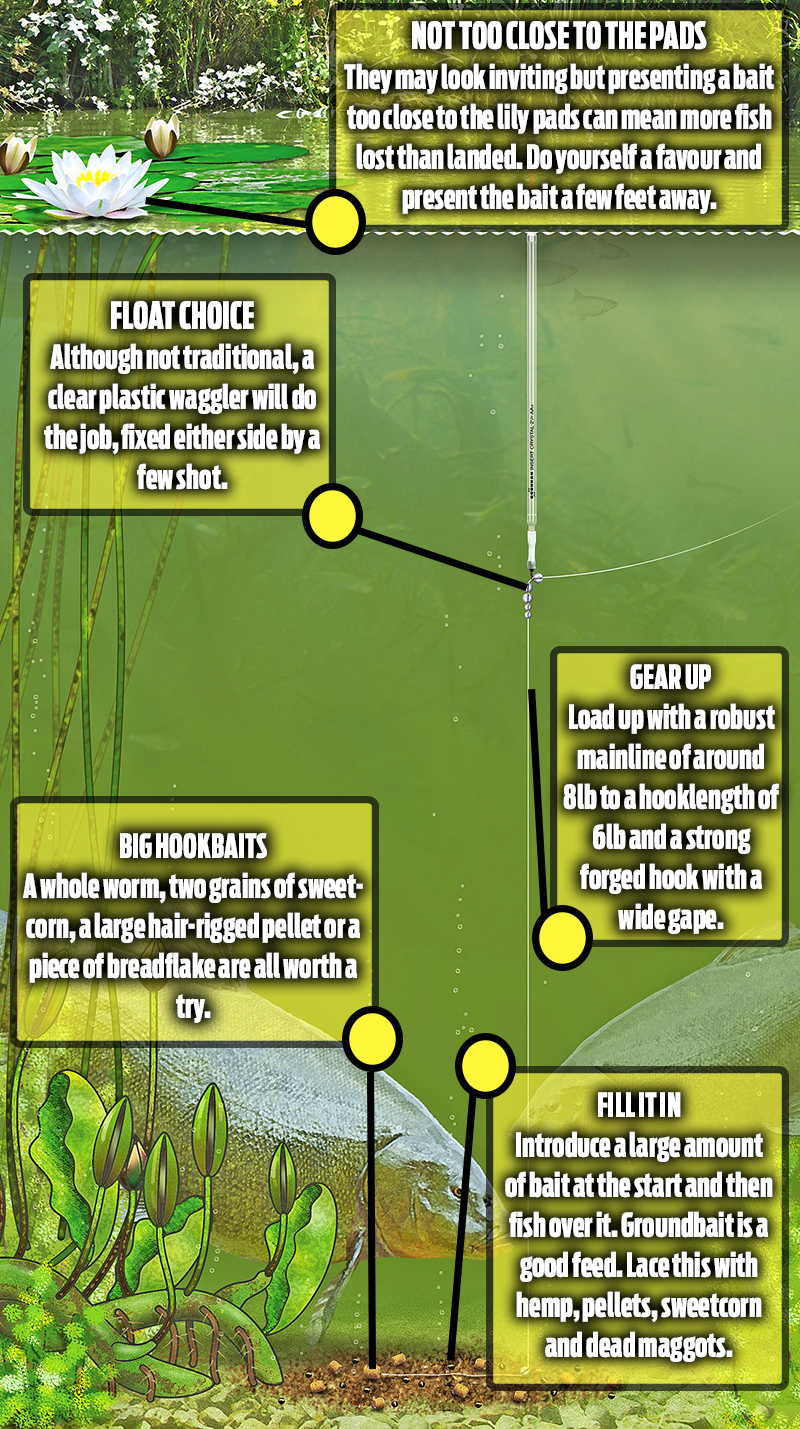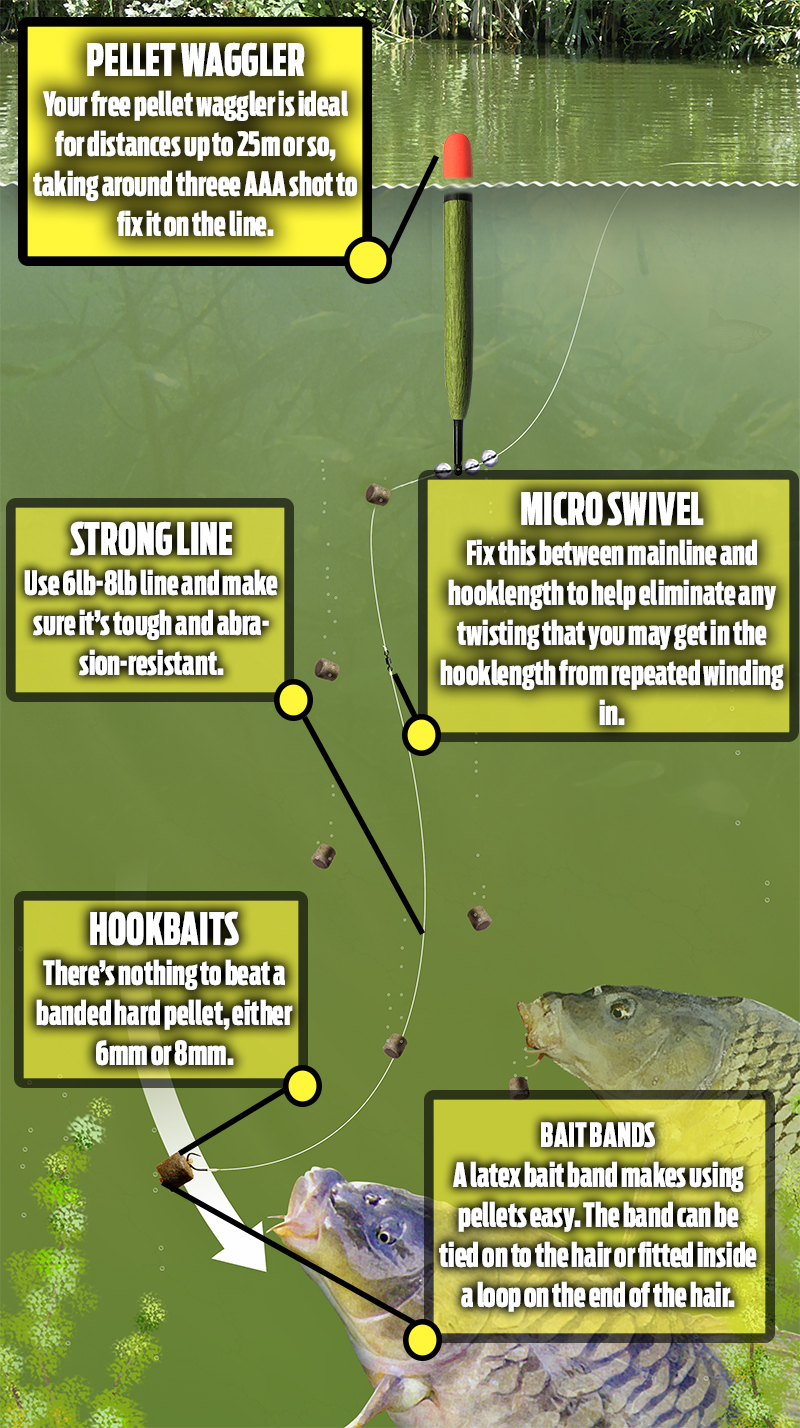Chub fishing rigs | River waggler rig
Chub are bold feeders, and will often sit in among smaller fish like dace, bleak and gudgeon.
For anglers, this means that one rig can be used to catch a real mix of species, and the waggler is by far and away the top attack for running water.
Versatility is the key trait of the waggler, allowing you to change from fishing a few feet deep one minute (if the fish show signs of coming off bottom), to dragging a bait along the riverbed, through to casting just inches away from far-bank tree cover.
1) Leave some tip showing
Because you will be running the float well down the peg, you need to be able to see it at range, and although the thick waggler has a highly-visible tip, don’t add too much shot to dot it down.
Ideally, leave most of the orange tip on show because bites will be very positive when fishing a bait at the full pace of the river.
2) Pick the right float
Should the swim be less than 4ft deep, a short very buoyant float known as a Specimen Waggler will be needed. It looks more like a pellet float designed for carp fishing on commercials. This float will not be dragged under easily and can ride uneven currents with ease.
For a standard deeper swim, look at a straight peacock waggler of 3AAA to 4SSG, depending on the distance needed to cast.
If you plan on fishing off bottom, think about an insert waggler with a thinner tip taking two or three AAA shot.
3) Shot down the line
In a shallow swims you’ll not need lots of weight down the line to get the bait to the bottom.
Two or three No8 shot evenly spread will do the job. If the peg is deeper, these can be pushed together to make a small bulk if needed, especially if bleak are grabbing the bait on the way down.
4) Regular loosefeed
Chub and dace will only be tempted into having a go if bait is constantly being introduced into the swim.
That means loosefeeding by hand or with a catapult, putting in a dozen or so maggots or grains of hemp with a few casters mixed in. Don’t break the feeding cycle and discipline yourself to keep the bait going in.
5) Fish at dead depth
If you set the float overdepth you’ll be in for a session of striking every time it is dragged under by the riverbed.
Spend a fair bit of time running the rig down the swim and making minute adjustments until the hookbait is just trundling along the bottom. To catch gudgeon or ruffe you will need to drag the bait overdepth, though!
Carp fishing rigs | Method feeder
There are a number of different types of rigs that you can use on commercials for carp fishing, and new versions and ideas are appearing all the time, but which one is really the best?
By far and away the most sensible choice is the Method feeder. It allows you to tuck a bait inside a ball of feed and have both mixed together once the feed breaks down in the water.
It’s also a self-hooking rig, meaning there’s no hitting tiny knocks on the quivertip. When a fish is on, you’ll know about it as the rod goes round!
Making the rig is easy, too. Most fisheries insist on your set-up being free-running, but modern tackle means that even elasticated feeders can be used safely.
Guru has its X-Safe system that allows the feeder to pull free of the line in the event of a breakage or the rig becoming snagged.
Elastic acts as a shock-absorber when playing a big carp under the rod-tip, which greatly reduces the number of last-minute hook pulls.
1) Lines and hooks
Big carp can give savage bites on the Method, so don’t skimp on lines. A tough mainline of around 8lb is the order of the day, matched to a 4ins hooklink of low diameter line in a similar breaking strain.
The short hooklink means that the bait will always be close to or in amid the feed. For hooks,
a barbless eyed carp pattern in sizes 16 or 14 will do. The eye is important, as it will allow you to hair-rig baits.
2) Top hookbaits
When a Method load breaks down, you want your hookbait to pop out and be easily visible to the fish, so give them something bright.
A hi-viz orange or yellow mini boilie or wafter, or a brightly-coloured 6mm pellet are good options but often, a plain hard pellet can bring equally good results. Don’t forget dead red maggots or a piece of corn either.
3) What to put around the feeder
Your feed is moulded around the frame of a Method feeder using a special mould, and there are only two choices of feed here – micro pellets or groundbait.
For out-and-out carp fishing, pellets work well. These need to be dampened slightly to help them stick around the feeder. Fishmeal groundbait comes into play when the carp are of a smaller stamp, and normally this is mixed 50/50 with micro pellets.
4) Feeder size
Method feeders range in size from tiny 15g models to massive versions taking over 50g. The size you pick is dependent on how far you need to cast, and any underwater countours.
For long casts, obviously a big feeder will do the job but for short chucks, a much smaller model will do.
Heavy feeders also come into play if you are fishing on an slope running away from an island, the extra weight helps the feeder to grip the lakebed as opposed to sliding down this slope.
5) Safe elastication
If you go down the elasticated feeder route, pick the Guru X-Safe system. This sees heavy pole elastic inside the feeder body stretch when a fish is being played, helping subdue the carp in double-quick time.
Should a fish get snagged and the mainline break, the feeder can pull free to prevent the carp being tethered.
Crucian fishing rigs | paste on the pole
Crucians are famed for their delicate feeding, and smaller fish can give hundreds of missed bites before you connect with them. However, big specimens are quite bold and a scaled-down carp approach picks them off well.
It’s all about presentation and placement of the bait. Much crucian fishing takes place at close range just a few metres off the bank, which makes the pole a sensible option for the angler.
Not only can you drop the hookbait in just the right place but you can keep the rig still and hit lighting-fast bites in a split second – far quicker than if you were using rod and line tactics.
1) Where to fish
Because crucians feed at close range, you need to spend a bit of time plumbing about the peg to find the ideal spot.
This will be just at the bottom of the marginal slope or shelf on a flat bottom free of weed or snags, but it can also be worth feeding a swim on top of this shelf close to features such as reeds or lily pads, provided there is a minimum of a couple of feet of water to play with.
2) Dot the float down
Rarely will a crucian pull the full bristle of a float under and often the only sign you’ll get is a sinking of a centimetre or so.
To counter this, shot the float to leave a tiny speck of float bristle showing. Any touch on the bait will immediately sink the tip.
3) Fish at dead depth
Presenting a hookbait overdepth will lead to missed bites. Crucians often give no indication at all on the float. Get an accurate depth reading and fish with the bait just touching bottom and you’ll give yourself a much better chance of seeing a bite and hooking the fish.
4) Scale down tackle
Crucians on the whole are not big fish, so strong arm tackle isn’t needed.
A rig resembling something you might use for roach will be fine, and that means a 3lb mainline, a hooklink of the same breaking strain but in modern low diameter line and a small lightweight hook. Look at size 18 or 16 hooks and a rg finished off with a slim pole float taking around half a gram.
Pick a float with a very thin bristle. This will show up every indication better than a thicker-topped float.
5) Go for paste
Maggots or casters may attract nuisance fish. Expander pellets are a good hookbait but big crucians just love a nugget of soft paste wrapped around the hook. The softer the paste the better, as the hook will pull through easily on the strike. Make your paste from a fishmeal groundbait, aiming to achieve a consistency similar to that of putty.
Shallow slapping rig for commercial carp
A) Back shots
Fix a few small No10 shot or Stotz between float and pole tip. This will help control the rig and also force you to keep your line tight meaning you’ll hit more bites.
B) Small float
A squat-bodied float will create the maximum amount of noise when it hits the surface, and by having a couple of small shot underneath to cock it, you can create a definite ‘plop’ as you slap. Pick a float taking around 4x8 or 4x10 shot.
C) The right depth
Slapping is designed to catch very shallow, so there’s no point fishing at 2ft deep. Begin at around 6ins deep – but F1s will constantly move up and down in the water so, if bites tail off, add a couple of inches to the depth to see if they’ve gone deeper.
D) A hooklength is essential
F1s are not known for tolerating thick lines, so using a lighter hooklength is a must. Don’t be afraid to drop down to as low as 0.10mm diameter if nothing much is happening – the thickness of the mainline won’t matter too much and, in fact, a thicker mainline will be less prone to tangling.
E) Small pellet hookbaits
Feed 6mm pellets and use the same on the hook. if you are missing bites, drop down to a 4mm bait on a smaller size 18 or even 20 hook. You should see your bite-to-hooked fish ratio rocket!
The lift method for tench fishing
The lift method for tench is the most traditional way of landing yourself a big tinca. there is nothing better than watching your float slowly slide under the surface before striking into a monster tench. We've pointed out some of the main areas to look at when setting for the lift method for tench fishing.
A) hookbaits
Use a biggish hookbait that the tench will take with confidence. For this there’s little to beat sweetcorn, fished as a single grain or in pairs.
B) Shot on the deck
As a general guide, shot the float with SSGs or AAAs and fish overdepth with the shot holding the bait still on the bottom. Fix the shot around 4ins from the hook, or more if the fish are finicky.
C) Attaching the float
Attach a straight waggler with a length of silicone tubing at the base and set the float so that its shot are on the bottom with the float tip visible at the surface.
D) how it works
After a tench has taken the bait, it upends, feels the weight of the shot and bolts. The float will lift, sometimes lying briefly on the surface, before shooting under quickly.
E) when to connect
You need to be patient when lift method fishing! The float may twitch and tremble for a while as a fish plays with the bait. Eventually the float will lift and then shoot under. Only then should you strike!
How to tie a method feeder rig for carp fishing
There are a number of different types of feeder to use on commercials for carp in early spring – but which one is really the best?
By far and away the top choice is the Method feeder, allowing you to tuck a bait inside a ball of feed and have both mixed together once the feed breaks down in the water. It’s also a self-hooking rig, meaning there’s no hitting tiny knocks on the quivertip. When a fish is on, you’ll know about it!
Making the rig is easy, too, as most fisheries insist on your set-up being free-running. The feeder is threaded on to the mainline and then stopped by a bead or stop above a short hooklength of around 4ins.
The bait is then buried inside the feed, with the mix moulded around the feeder.
As this feed breaks down quickly once in the water, the bait is exposed and the bite normally isn’t long in coming.
By keeping a tight line between feeder and rod, bites are extremely positive and often result in fish hooking themselves.
A) Feeder weight
A feeder of around 15g to 30g in weight is fine. The only change here would be when fishing on the slope of lakes where the water starts to shallow up leading to the margins, such as you’d find when casting to a far bank or an island. In this situation, a slightly heavier feeder will be needed to grip the slope and stop the feeder rolling down into the deep water.
B) Feeder type
There are a variety of Method feeders available but these can be narrowed down to in-line or elasticated versions, a flatbed being the best shape. This is a perfectly flat feeder that will sit flat on the bottom. Fishery rules often dictate whether elastic can be used. An inline model is safer, and works by having the line running through the body.
C) Hookbait
Any bait will work, but anglers do like to try and use on the hook what they’re putting around the feeder. A banded or soft 6mm pellet is often the number one choice, but in clear water, a brightly coloured 6mm or 8mm mini boilie can produce surprising results.
D) Feed
When it comes to feed you have a choice of groundbait or pellets with the Method. A fishmeal groundbait with a few small 2mm micro pellets dampened down before use is fine, but if you are fishing for just carp, do away with the groundbait and load the feeder up with just micro pellets.
How to tie a PVA bag pop-up rig
PVA bag pop-up rig
With luck, carp are feeding off bottom at the moment, but not necessarily just under the surface, and a bait fished hard on the deck can fail to catch. What you need is something that can be placed at varying depths off bottom to pop a bait right in front of carp swimming around. A pop-up boilie is king in this instance.
But what do you feed? Sometimes, nothing is needed, relying on just the power of the pop-up to get a take, but when some bait is called for it should be kept tight and to a minimal amount. That’s where the PVA bag comes into play.
Tightly packing a PVA mesh bag with both sinking and floating pellets and making it the size of a £1 coin, the bag can be either nicked on the hook or wrapped around the lead with PVA tape and cast as far as you need it to go. When the rig settles, the bait will pop up and the bag will dissolve, releasing those goodies. By using a four seasons-style PVA, the bag will dissolve even in cold water.
A) Pop-up choices
For the hook, bright is best and lurid-coloured pop-ups are favoured. Fluoro pink, yellow or white are all good choices, using a 12mm or 14mm bait on a hair rig, although large pellets can also score, especially when used in conjunction with pellets in the bag.
B) How far off bottom?
This is open to choice and can change throughout the day, but a starting length of 2ft is advised, altering this if no indications are forthcoming. Sometimes, a change in depth by as little as 6ins can trigger a change to a bite every cast. This alteration is normally made by lengthening the trace to pop the bait up even more.
C) Hooklength materials
Fluorocarbons are popular among carp anglers for this purpose as they’re hard for fish to see underwater.Korda’s IQ2 remains a big seller. In terms of strength and breaking strains, 10lb to 12lb will work on most ‘runs’ waters, upping that to 14lb or heavier if the swim is snaggy or the fish very big.
D) Running rig
For simplicity and ease of use, fish a running rig with the lead stopped by a rubber bead before the swivel. This will produce a more positive bite on the rod-tip or bite alarm, and it also keeps within the rules of many fisheries.
Cage feeder rig for bream fishing
Match-style cage feeder
there are few more classic ways of catching bream than the cage feeder fished at range on big lakes. It’s the go-to method for match and pleasure anglers alike and still accounts for numerous big match wins, despite the advent of the Method feeder.
At this time of year, fishing for bites is the name of the game. A tidy net of smaller skimmers plus the odd proper bream is more than welcome, but if you plan on fishing the cage feeder, you have to first think about how much bait is going into the water.
There’s no place for piling in lots of bait at the start as you would in the summer – a more gradual baiting up attack will reap rewards and that means making just a few early casts to deposit three or four loads of groundbait and freebies into the swim and then then relying on each cast to top the peg up.
Running or fixed?
Fishery rules may dictate whether you can use a fixed rig such as the one shown here. If both are allowed, the choice if yours. A running rig will tangle less and sees the feeder run directly on the mainline, stopped just above the hooklength. A fixed rig can result in a better bite and more bream hooked. It involves trapping the feeder inside a 6ins-8ins loop in the mainline. The feeder can still run, but will stop when the rig is pulled a certain distance by a fish picking the bait up. In this instance, it’s possible that the bream will hook itself.
A) Top baits
Ringing the changes on the bait front is an important skill to master. Double red maggot makes a good starting bait, but a worm or even a grain of corn can pick off the bigger bream. Dead maggots are equally good, especially on silty waters, and don’t forget double caster as a super bait if you are feeding plenty in the feeder.
B) Hooklengths
A 50cm hooklink is good for starters. If you are getting bites but missing them, shorten the link by 10cm at a time until you hook fish. Going longer can work on harder days, or if you think that the fish are sitting just off bottom and watching the bait fall.
C) Groundbait and goodies
If your venue sees a lot of pellets fed, add fishmeal to your groundbait mix. A 50/50 split of sweet bream groundbait and fishmeal will work, but modern sweet fishmeal groundbaits will do the job for you. Darker groundbaits work better in clear conditions. On a commercial, add micro pellets. On natural lakes casters, dead pinkies and finely-chopped worm are best.
D) Cage feeder
A metal cage feeder is heavy and can be cast a long way. The contents empty fast, especially useful in shallow water. On deep lakes, you may be better using a plastic open-end with fewer holes for the feed to get out of. Pick a medium model of a weight that allows you to reach the distance you want to fish at.
E) Looped boom
To cut down on tangles with a fixed rig, tie several small loops in the mainline immediately below the loop that the feeder sits in. This creates a stiff boom that will ensure the hooklength sits at an angle away from the feeder on the cast.
Specimen method feeder rig for bream
Specimen-style Method feeder
Big bream require a very different approach compared to that of a match angler. Regular casting and changes to the rig and hookbaits, are replaced by a bait and wait approach.
This can see one cast made every six or seven hours, biding your time for the bream to find the carpet of feed put in before you start fishing. Much of the action can take place after dark, so that means fishing with bite alarms and a rig that will help a fish to hook itself. A large, heavy Method feeder with a short hooklink and a hair-rigged bait on a tight line direct to the rod means that a bream picking up the bait will run and trigger your bite alarm.
A) Fake baits are best
To stop your hookbait being whittled away by little fish use rubber corn, maggots or casters. Rubber casters, in particular, are very good when you’re putting plenty into the swim. Fish three on a hair rig. If there’s a bit of weed on the bottom, invest in buoyant fake baits to sit just off the lakebed.
B) Short braided hooklinks
The Method feeder involves short 4ins hooklinks whether you’re after carp on a commercial or big bream on a vast lake. A shorter link helps the self-hooking effect and many specimen hunters use braid instead of mono, as it is stiffer and more robust.
C) Feeder size
Go big with your Method feeder in terms of both weight and size. A big feeder will let you get more bait around it, and a heavy model will cast far enough – most big bream fishing takes place on a good long cast. Don’t be afraid of using a 50g feeder to hit the spot. Naturally, the feeder will run on the mainline.
D) What’s in the mix?
Bream love groundbait, so this should make up the bulk of your feed to go around the feeder – but adding plenty of bits and bobs to it will help keep the fish milling around. Hemp, micro pellets, casters and dead maggots will make a good base mix but ensure that your groundbait is very sticky so it can accommodate all these particles and stick around the feeder for a long cast.
How to tie | Specimen method feeder rig
Imagine if there was presentation that allowed you to present a hookbait over any type of lakebed - even thick weed - leave a tight pile of freebies around your hookbait and the chances are no one else on your lake is using it.
Sounds too good to be true, doesn’t it? Well if you delve into the back of your tackle cupboard you’ll probably unearth exactly what you need for this deadly set-up.
Around 15-years ago Method feeders were all the rage. Visit any day-ticket lake and compacted balls of groundbait could be seen being cast out from all pegs. But in recent years pellets and PVA in its various forms have seen the Method feeder all but resigned to the annals of carp fishing history.
One of the main disadvantages of PVA is that you are limited to which baits you can use. Anything that is too wet and not PVA friendly will cause your bag to melt before it hits the water. There are no such problems with a Method feeder. The only real limit to what you can add to your Method mix is your imagination. These allows you to create bespoke mixes that no one else on your water will be using.
Use a short supple hooklink like you would when fishing a solid PVA bag creates a bolt effect as any fish that picks up the hookbait will quickly come into contact with the full weight of the feeder and set the hook.
1) Baits such as a single grain of fake corn or a 12mm boilie work well on the Method
2) A 4in hooklink ensures that fish quickly come into contact with the full weight of the feeder
3) An anti-tangle sleeve helps to push the hooklink away from the feeder
4) Compacting bait around the frame enables you to present a bait over virtually any type of lakebed - even thick weed
5) The Method can be fished on either tubing or leadcore
How to tie | The pellet feeder rig
Twenty years ago you’d never had thought of fishing pellets on a river for barbel, but today they’re the go-to bait for many anglers.
Nuisance species such as perch, roach and eels aren’t keen on pellets, so that lets the barbel angler fish in confidence, knowing that when the bite alarm goes off it should be their target fish on the other end.
Pellets can be used on the float, but it’s with a feeder that they work best, fished on a Method feeder or in an open-end where a mixture of micros, 4mm and 6mm halibut pellets are mixed with a little fishmeal groundbait, finished off with a hair-rigged 10mm or 12mm halibut pellet hookbait.
The fishy smell of the pellets draws the fish in, making the feeder effective on powerful rivers like the Trent and Severn.
1) Mixing pellets
The best catches come to those anglers giving the barbel a mix of pellet sizes to browse over. Invest in everything from micros to big 10mm or 12mm baits.
2) Method or open-end?
If your river is relatively slow in pace, a Method feeder can catch but, for strong flows, an open-end feeder can get more bait into the swim on each cast.
How to tie | The bomb and worm rig
Worms – no perch angler would fish without them, and while the species will take a bait that’s drifting past them, when fishing to cover a static bait gets much better results.
Perch will tuck themselves under trees or close to snags, waiting for prey fish to go past, so popping a big lobworm right in front of them is an invitation too good to refuse.
A whole lobworm is a good, active bait, but two tail sections can be even better, as the broken worms give off attractive natural juices that spread through the water. Fish them on a size 8 hook with a simple running set-up using an Arlesey bomb – one of Dick Walker’s own inventions for tackling the lake of the same name – and a long tail of modern fluorocarbon line.
Feeding in this sitation is hard, but if you want to add some pices of chopped worm, make a few casts with a blockend feeder instead of the bomb.
1) free-running set-up
This streamlined lead is fished on a running rig comprising the bomb on a link swivel to a run ring. It’s topped by a tulip bead pushed into the swivel carrying the hooklink.
2) Arlesey bomb
This streamlined lead was developed specifically for perch fishing by Dick Walker for distance casting on deep lakes, but is now the go-to lead for many other scenarios.
3) Red maggot teaser
Two lobworm tails on a size 8 wide gape hook are the perfect medicine for specimen perch, but why not tip the bait off with a single red maggot for that extra bit of movement?
4) big bait for big perch
Perch do not chomp down on prey like pike, but ‘inhale’ it – and there’s not much their capacious mouths can’t take in. Two big lobworm tails will deter the smaller stripeys.
How to tie | The stealth pellet waggler rig
Setting up this pellet waggler rig couldn’t be easier if you think about how to get the best results from the rig that you are using follow our simple and easy steps to helping you tie one of these great pellet waggler rigs
1) Foam wagglers are relatively light so I fish them on 5lb Guru Pulse mainline to get maximum distance on the cast.
2) Purpose-built weighted adaptors for all three sizes of foam waggler mean you don’t have to put shot on light mainline, which could potentially damage it. These adaptors take the float down to the perfect level, and help it sit immediately.
3) A Guru pellet waggler snap link swivel allows me to change the size of waggler quickly and without fuss when the need arises.
4) To keep the waggler in place I use three small line stops. That way I can chop and change the depth without fear of damaging the line.
5) Below this I tie on a size 14 Cralusso Quick Snap Swivel which allows me to quickly change my hooklength while keeping everything neat and free from tangles.
6) For this type of fishing I tie my hooklengths 12ins long and for carp in the 4lb-10lb bracket I will use 0.17mm N-Gauge.
7) The hook will be either a size 16 or 18 super MWG pattern, depending on the size of pellet on the bait band. I’ll start with the rig set around 18ins deep with a view to coming higher in the water as the day progresses. I always prefer to start deeper, because that way I can get a better impression of what’s going on below the surface
How to tie | The slow sinking feeder
During summer fish will often be stationed well up in the water, especially on deeper lakes where they will find a depth where the light-levels and temperature suit them.
At short range this situation is ideal for fishing a waggler rig with the shot well spread so that the hookbait falls at a slow rate, matching that of the free offerings.
But what if you are fishing beyond float range? On big rivers, reservoirs and large gravel pits, roach, rudd and bream will often not come within 30 metres of the bank. This is where the on-the-drop feeder comes into its own.
By using a long hooklength and a lightweight feeder the time it takes the rig to settle is extended, giving fish plenty of time to intercept the hookbait on the drop.
Bites can be expected at any time. It is not uncommon for the quivertip to never signal the feeder touching down, as a fish intercepts the bait in mid-water. Also, bites can be expected within seconds if the feeder does hit the bottom. There is no point in leaving the feeder once the rig has settled on the bottom.
Within a minute or so of casting, wind in, rebait and recast to keep a constant cloud of attractive bait falling through the water column.
Thread a Medium Grip Mesh feeder on to your mainline. Choose a feeder weight of around 14g-28g
Follow the feeder with two small rubber beads. These act as a shock-absorber cushioning the feeder on the cast
Fold over the last 30cm ofmainline and tie a large loop. Next, tie four further loops inside the large loop at regular intervals
Ensure that the beads and feeders come to rest on the uppermost knot. If they slide over, tie a second knot over the first
Cut off a 120cm length of hooklength. Use hooklengths of 90cm-180cm to vary the sinking speed of the hookbait
Tie on the hook using a spade-end knot where the hooklength line has been first passed through the eye of the hook
Once you’ve attached the hook, tie a figure-of-eight loop knot in the other end of the hooklength
To complete the rig, simply attach the hooklength to the mainline using a loop-to-loop knot
How to tie | The rocket feeder carp rig
There are many different ways of catching carp up in the water, but one of the most effective is the Rocket Feeder.
As the name suggests, this is a floating feeder that is open at one end, enabling it to be filled with lightly dampened pellets or groundbait, which should be mixed so that it quickly exits the feeder once cast out.
Unlike other tactics, the Rocket Feeder is ideal for use with larger pellets, such as 8mm baits, enabling the angler to introduce sizable food items – ideal for larger carp. The feeder can also be cast long distances, thanks to its aerodynamic shape, so it’s useful when carp are beyond pellet waggler range.
The shape of the feeder means that it acts as a very effective bolt-rig when a carp takes the bait. In fact, it is essential to use strong line with this tactic to avoid being broken on the take. A minimum of 6lb is recommended.
Set the Rocket Feeder about 4ft above the hook then, as the carp become more accustomed to the stream of bait, move the float stops down so that the hookbait is just 2ft deep.
On heavily stocked carp fisheries the Rocket Feeder is an absolute winner at this time of the year. Get on it now!
Slide a float stop on to the mainline, followed by the Rocket Feeder, and then fix two further float stops to lock it in place
Adjust the float stops to lock the feeder in position. Having two stops below the feeder ensures that it will not move on the cast
The feeder should be locked about 3ft above the end of the mainline
Tie a figure-of-eight knot in the end of the mainline to form a small loop which you will attach the hooklength to
Use a four-turn grinner knot to attach the hook. Use a clear line a this is less visible when fishing up in the water
The hooklength should be 1ft long and attached to the mainline using a loop-to-loop knot. Attach the hookbait using a bait band
How to tie | Carp and tench float leger rig
An important rig for any budding carp, tench or bream angler is the float ledger rig as it helps target species which prefer an absolutely static bait. Use strong line and hooks with this rig, and big baits such as worms, bread, or mini boilies.
A large bodied waggler is required as the buoyant stem is less likely to be pulled under by the tow. Bites are normally indicated by the float shooting under.
A good tactic is to find the bottom of the marginal shelf – where the bottom levels out – and then set the float slightly overdepth. Now, when you tighten up the line, the float will slowly sink down to the correct position and the line will be tight from rod to the leger weight.
If you find yourself fishing a lake this year with the wind blowing straight towards you, or from side-to-side, and holding position is proving impossible, then try out this very effective, but surprisingly underused rig to give you the correct bait presentation to encourage bites. Check out our step by step guide below and tie it yourself.
Trap the float on the mainline with two float stops. The float should be a large bodied waggler as this is more stable in undertow
Use a swivel leger weight of between ¹/2 to 2/3 ounce. This should be free-running on the mainline for sensitive bite indication
Thread a mini buffer bead on to the mainline and then attach a mini swivel to the mainline using a four-turn grinner knot
Tie a size 12 hook to 10 inches of 5lb hooklength line. Use either a grinner or through-the-eye whipping knot
You need to keep the hooklength short – about 4in-6in will be perfect. Tie the end of this to the mini swivel
The lead weight will sit just above the buffer bead, creating a bolt-effect. Adjust the float so that just the tip is showing
Essential river roach rigs
Roach are very obliging and will often give you a few bites when not much else is happening.
Legering is worth a go but the truly classic way to catch roach from a river is to floatfish with a waggler or stick, running the hookbait down the swim with the pace of the flow and loosefeeding regularly. Over time you can build the swim up so it draws more and more fish in. As a result, the fishing gets better and better.
Should you find yourself on a slow, deep river it’s time to turn to the pole. This is a very positive way to fish with a big float in conjunction with groundbait to get the bait down fast. It gets far quicker results than rod and line.
Water conditions play a big part in choosing your tactics. As a rule of thumb, colour in the water lends itself to feeding groundbait and fishing the pole, while gin-clear rivers are best approached with the float and loosefeed.
River pole rig
Offering precision feeding and bait placement, along with delicacy of presentation, it’s no wonder the pole is the number one choice of match anglers.
But the pole is also a very attacking method, should you be faced with lots of roach. You can get the bait down quickly using a big float, feed plenty and hit bites with more accuracy than with a waggler or stick float.
Better still, if you can get the fish at short range, a long pole or whip to hand can be quicker still!
Top hookbaits
Begin with maggots, ideally a single bronze maggot. This will get you quick bites, but have an eye on changing to something like a caster or even a grain of hemp later in the session to search out quality fish. Feeding hemp and caster will give you the best chance of catching on both, as the fish will become used to them over time.
River waggler rig
Few methods lend themselves to fishing a river better than the waggler. This float allows you to cover a lot of water, fish at different depths and present the bait well overdepth or just tripping bottom – it’s that versatile!
To truly search a peg out for roach, gear up with a straight thick peacock waggler that’ll let you drag line on the bottom to slow the bait down without it being dragged under.
This method, when fished with loosefed maggots, is brilliant and gives you the chance of catching a bonus chub or two as well.
River maggot feeder rig
Perfect for introducing small consignments of bait into tight spots such as overhanging snags where the fish lurk, the maggot feeder is also perfect for catching roach in clear river conditions when groundbait may prove to be a bit of a turn-off.
Regular casting, say every five minutes, will build up a stream of bait in the peg, which in turn will draw roach from downstream over time. When it works, the maggot feeder should produce bites within seconds of it hitting bottom.
Top 5 pole rigs that you need to try!
No matter where you choose to fish this month, you can guarantee that your target species will come close to the bank in search of food now that the temperatures have risen sharply.
When this happens, the pole is an unbeatable item of tackle but the sort of rig you use with it will dictate whether you get just a few bites or have a session that you won’t forget in a hurry.
Paying careful attention to your terminal tackle and bait choices is vital if you want to make the most of your time on the bank, as is getting the subtle details such asshotting and float patterns spot on.
We reveal the five most deadly spring pole rigs that are almost certain to help you and your friends put more fish in the net.
The Worm Rig
GOOD FOR: Putting together big mixed bags of quality bream and tench on stillwaters.
TACKLE: Use a rugby ball-shaped float with 5lb mainline, a 4lb hooklength and size 14 or 16 hook.
HOOKBAIT: Half or a full worm will appeal to both species at this time of year.
The Maggot Rig
GOOD FOR: Quality roach that will only feed if the hookbait looks natural.
TACKLE: Keep it light with 3lb mainline, a 2lb hooklength and a size 18 or 20 hook.
HOOKBAIT: Red maggots will keep the bites coming. Alternate between single and double.
The Pellet Rig
GOOD FOR: Catching F1s and carp in open water swims on commercials.
TACKLE: A narrow float will help you spot every bite. Use 5lb mainline to a 4lb hooklength and a size 16 hook.
HOOKBAIT: Start with a 4mm expander, switching to a banded pellet if small fish show.
The Margin Rig
GOOD FOR: Catching the biggest carp and F1s in the lake, especially late in the session.
TACKLE: Don’t risk getting bust by a big carp and use 6lb mainline to a 5lb hooklength. A strong float with a thick tip is a must.
HOOKBAIT: Corn is unbeatable in the margins.
The Meat Rig
GOOD FOR: Fishing in open water for carp, F1s, big bream and tench on commercials.
TACKLE: A balanced rig helps catch all species. Use 5lb mainline, 4lb hooklength to a size 16 hook.
HOOKBAIT: A 6mm cube of meat will catch all species that are stocked in the fishery.
Three pellet waggler rigs to fish this weekend!
A waggler is the most versatile float of all, capable of catching fish from rivers, canals, commercials and massive natural lakes.
But within the waggler family there are groups of floats that have very definite roles to perform. These include the pellet waggler for distance fishingup in the water, and see- through plastic floats for use on gin clear waters.
At this time of year, when the weather can change drastically from one day to the next, being adaptable is the key to catching.
To make sense of the types of waggler, how the rig should be set up and the best baits and feeds to use, try these rigs that will cover just about every base over the next few weeks…
Insert waggler rig for silver fish
Fish can be caught on commercials at a range of depths in spring, so if there was one versatile float to pick it’d have to be the insert waggler. This rig is a simple to make waggler set-up for tackling a typical lake swim up to 8ft deep.
Waggler rig for tench
There are few more evocative sights in fishing than a float poised next to a patch of lilies, ringed by the tell-tale pinhead bubbles of feeding tench. This rig allows you to fish what’s known as the ‘lift’ method, using a large shot on the lakebed.
Pellet waggler rig
The pellet waggler rig is all the rage right now but how do you fish it? Well setting the pellet waggler up is easy to do and a brilliant option in May and June when the weather starts to warm up.
The helicopter feeder rig
The helicopter feeder has become a mainstay for a great many anglers fishing for species as diverse as specimen roach, tench and carp.
This rig has two main advantages. It is very tangle-proof, especially when higher diameter line is used for the hooklength and also an effective bolt rig, meaning that most bites will be very positive.
Coupled with a maggot feeder, this is an excellent set-up for big roach. With a larger oval maggot feeder, it lends itself well to fishing for tench. The hooklength should be as short as possible, generally around 3in-6in, which can be quite tricky to tie, but persevere, because the resulting rig is well worth the effort.
The hooklength should be stopped just above the feeder, although not so close that the hook can accidently foul the feeder on the cast. As a general rule, the closer the hooklength is to the feeder the more bites you will get.
This is the ideal rig to tie if you plan to fish a ‘sleeper’ rod while float fishing, because generally the bites are unmissable. For this reason, it pays to use a reel with a freespool facility that can give line when a fish bolts away.
How to tie
Cut off 20cm of Power line. This hooklength should not be too fine to avoid tangles
Tie on the eyed hook using a through-the-eye whipping knot with 12 turns, for a great angle
Thread a Rig Sleeve on to the other end of the hooklength, tapered end towards the hook
Tie on a Micro Rig Swivel using a twice-through-the-eye four-turn grinner knot
Thread a soft Line Stop on to the mainline, which should be at least 6lb to avoid breakages
Thread on the hooklength swivel, followed by a second Line Stop leaving a 5mm gap
Thread another Rig Sleeve on to the mainline. Tie on swimfeeder using a four-turn grinner
Slide the stops and hooklength into position so that the hook rests just above the feeder

